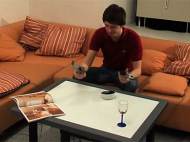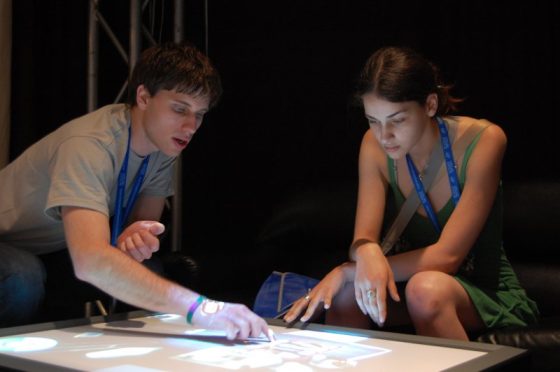CRISTAL system could replace most of your remotes
 Instead using a bunch of remote controllers, or extremely complicated universal remote controller, you could try a user interface that attempts to create more natural way of controlling and connecting with devices. CRISTAL (Control of Remotely Interfaced Systems using Touch-based Actions in Living spaces) is a user interface technology used for control of multimedia devices and home automation systems. The technology represents a mixture of a coffee table with a universal remote, giving the control of the surrounding appliances to the people sitting around the table.
Instead using a bunch of remote controllers, or extremely complicated universal remote controller, you could try a user interface that attempts to create more natural way of controlling and connecting with devices. CRISTAL (Control of Remotely Interfaced Systems using Touch-based Actions in Living spaces) is a user interface technology used for control of multimedia devices and home automation systems. The technology represents a mixture of a coffee table with a universal remote, giving the control of the surrounding appliances to the people sitting around the table.
The amount of digital appliances and media found in domestic environments has notably risen over the last decade. As these devices become more compatible to Internet and wireless networking and as networking and WiFi home infrastructures become more prevalent, new opportunities arise for developing centralized control of these numerous devices and media into so called “Universal remote controls”. The system provides a novel experience for controlling devices in a home environment by enabling users to directly interact with those devices on a live video image of their living room using multi-touch gestures on a digital tabletop.
CRISTAL uses a camera to capture the living room and all the devices in it, including lamps and digital picture frames. The captured video is displayed on the multi-touch coffee table. The video image of the device itself is the interface, so a sliding gesture on the image can turn up the volume of the TV, for instance. To watch a movie, drag an image of the movie cover and drop it on to the TV on the multi-touch screen.
“We wanted a social aspect to activities such as choosing what to watch on TV and we wanted to make the process easy and intuitive,” said Stacey Scott, assistant professor at the University of Waterloo in Ontario, Canada, and a member of the project. “Every time you get a new device into the living room, you get a new remote with it,” said Scott. “And instead of difficult programmable universal remotes, this offers intuitive mapping of the different devices and home.”
Scott and researchers from the Upper Austria University of Applied Sciences have been working on the idea for less than a year. It started when Michael Haller, the head of the Media Interaction Lab at the university, found himself frustrated with different remotes for each device: TV, radio and DVD player.
Although the expected price of this great system isn’t quite affordable, the researchers are confident that the idea can become viable enough for consumer production in a few years, especially if it can be combined with Microsoft’s Surface product. Beside the controlling features, the system could be used for security purposes as a surveillance system while you’re away. The only downside of this project is the fact you can’t carry your coffee table around with you and use it from various places of the room, as you can do with remote controllers.










Leave your response!